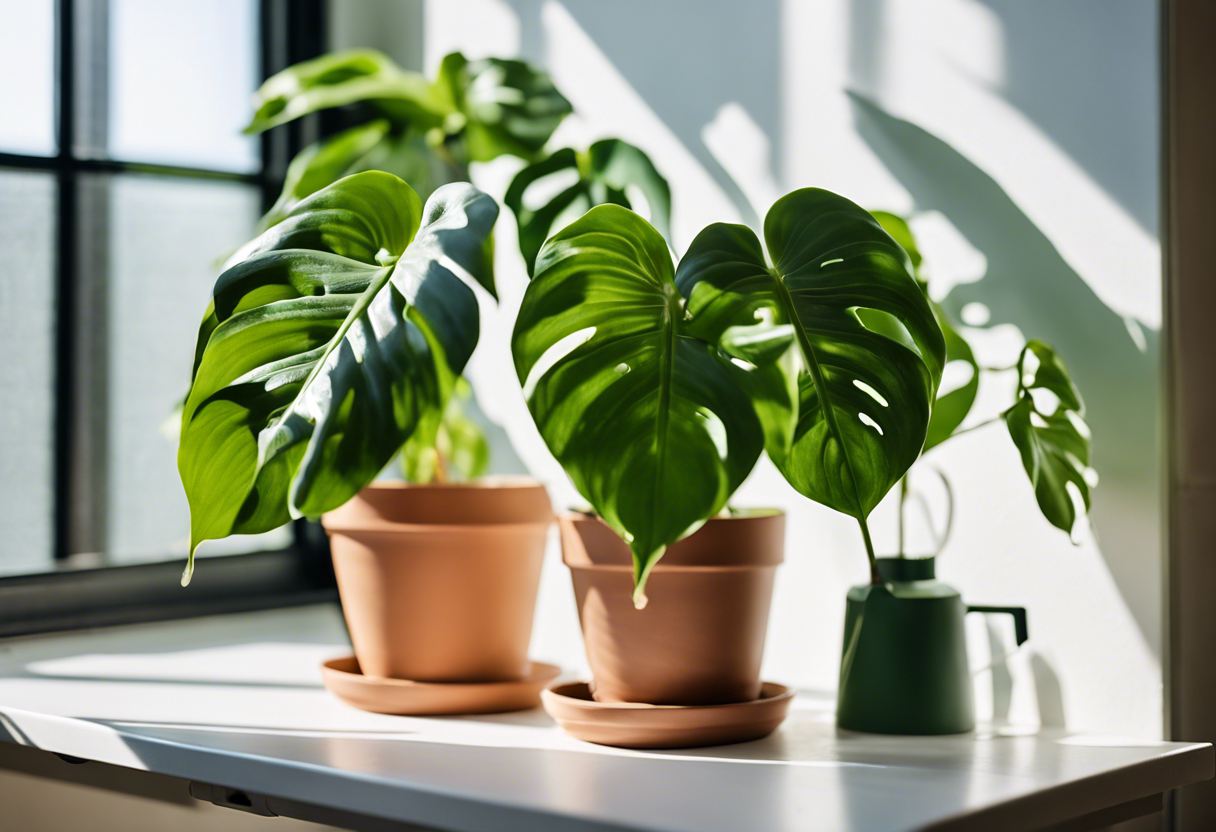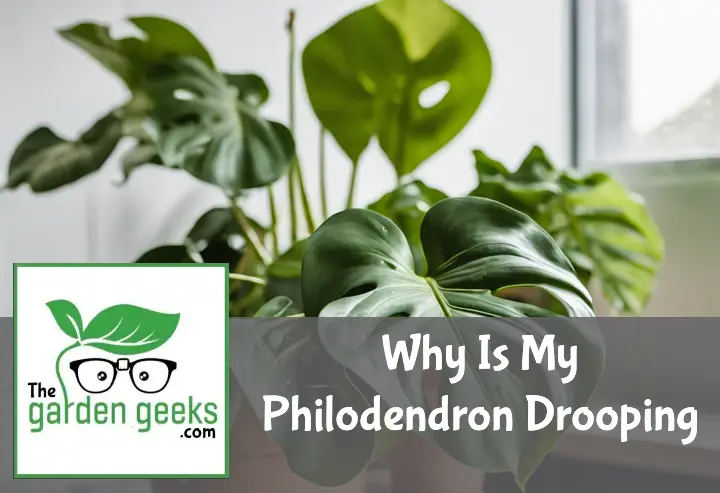Hey there, fellow plant parent! If you’ve found yourself here muttering under your breath, “Why is my Philodendron drooping?”, then you’re in the right place. I remember when I first noticed my own Philodendron looking a bit down in the dumps – quite literally.
Fear not, though! In this blog post, we’ll explore some common causes for this sad state of affairs and how to perk your leafy friend back up. So grab a cuppa, sit back and let’s dive into the world of Philodendrons. Keep reading about ‘Why Is My Philodendron Drooping?’
Key Takeaways
- Philodendrons droop due to overwatering, underwatering, inadequate light, temperature stress, or poor soil quality.
- Overwatering causes root rot which leads to wilting. Let the top inch of soil dry out between watering.
- Underwatering results in droopy leaves. Water when the top inch of soil is dry.
- Too much direct sunlight can burn the leaves causing them to droop. Indirect bright light is ideal.
- Extreme temperatures cause stress and drooping. Maintain a temperature between 65°F and 85°F.
- Poor soil quality affects nutrient absorption leading to drooping. Use well-draining, rich organic soil.
Understanding Philodendron Plants
Welcome to the lush, leafy world of Philodendrons! These plants are like the cool kids on the block in the plant kingdom. They’re trendy, they’re diverse, and they’ve got this laid-back vibe that says “Hey, I’m chillin’ here.”
What is a Philodendron?
So what exactly is a Philodendron? Well, it’s a type of plant that hails from the tropical regions of America. It’s known for its stunning foliage and easy-to-care-for nature. The name ‘Philodendron’ comes from Greek words meaning ‘love tree’, which is pretty apt considering how much we adore these plants.
These beauties come with an array of characteristics that make them stand out. From their heart-shaped leaves to their climbing or trailing habits, there’s something about Philodendrons that just draws you in. And did I mention they’re indoor-friendly? Yep, these guys love hanging out indoors as much as they do outdoors.
Different Types of Philodendron
When it comes to types of Philodendrons, oh boy, are you spoilt for choice! There’s the Heartleaf Philodendron with its adorable heart-shaped leaves (hence the name). Then there’s the Lacy Tree Philodendron – this one’s a bit more dramatic with its large lobed leaves.
But wait, there’s more! You’ve got your Split-leaf Philos and your Elephant Ear Philos…the list goes on. Each type has its own unique charm and personality but remember – no matter which type you choose, they all share one thing in common: an undying love for being well-cared-for.
Ideal Conditions for Philodendron Growth
Now let’s talk about creating the perfect pad for your Philodendron. These plants are all about that bright, indirect light. They’re like Goldilocks – not too much light, not too little, but just right!
As for watering, Philodendrons prefer their soil to be kept moist but not soggy. Think of it as a sponge – you want it damp, but not dripping wet. And remember, when in doubt, it’s better to underwater than overwater.
So there you have it! A quick crash course on why is my Philodendron drooping and how to keep your Philodendron happy and healthy. Remember, every plant has its own personality and needs – so take the time to get to know yours!
Common Causes of Drooping in Philodendrons

When you ask, “Why Is My Philodendron Drooping?“, it’s often due to a few common philodendron care mistakes. Let’s dive into these causes of plant drooping, so you can avoid these common philodendron problems and keep your green buddy happy.
Overwatering or Underwatering
Overwatering and underwatering are like the Goldilocks of plant care – too much or too little, and your philodendron will start drooping. Signs of an overwatered philodendron include yellow leaves and a soggy base. On the flip side, if you’re underwatering, your plant might have brown, crispy edges.
The key is finding that “just right” amount of water. So how do we correct this? Well, for overwatered plants, let the soil dry out before watering again. If you’ve been underwatering, gradually increase your watering schedule until those leaves perk up again.
Inadequate Light Exposure
Just like us humans, plants need their sunshine! Inadequate light exposure can cause your philodendron to droop. The effects of low light on philodendrons can be pretty dramatic – think dull color and slow growth.
So what’s the solution? These plants love bright but indirect light. Try moving your plant closer to a window or use artificial lights if necessary. Remember, it’s all about balance – too much direct sunlight can also harm your plant!
Temperature Stress
Extreme temperatures are another culprit behind a droopy philodendron. The impact of temperature stress on plants can be quite severe with wilting leaves being a common sign.
Philodendrons prefer temperatures between 65-80°F (18-27°C). So try to keep them away from drafts or heaters. And remember, if you’re uncomfortable with the temperature, chances are your plant is too!
Poor Soil Quality
Lastly, poor soil quality can lead to a drooping philodendron. Your plant needs nutrient-rich soil to thrive and proper drainage to avoid water-logging.
If your philodendron is drooping despite perfect watering and lighting conditions, it might be time to check the soil. Consider repotting with a high-quality potting mix or adding some compost for extra nutrients. Remember, happy soil equals a happy plant!
Diagnosing Your Drooping Philodendron
When your Philodendron starts to droop, don’t panic! It’s a cry for help, and the key is to diagnose the issue correctly. Whether it’s overwatering vs. underwatering, light and temperature conditions, or soil quality – getting your Philodendron care right is crucial to revive those drooping leaves.
Signs of Overwatering vs. Underwatering
Overwatered and underwatered Philodendrons can both end up with droopy leaves, but the signs are different. If you’re dealing with an overwatered philodendron, the leaves will be yellow and wilted. They might even fall off!
On the other hand, if you’ve been underwatering your plant, the leaves will look dry and brittle. They’ll also curl inward as if trying to conserve water. So next time you’re unsure about your plant watering guide, remember these symptoms.
Assessing Light and Temperature Conditions
Light and temperature play a huge role in keeping your Philodendron happy. Too much light can scorch the leaves causing them to droop while too little light can stunt growth.
The ideal scenario? A spot with bright, indirect light is what your Philodendron craves! As for temperature, these tropical beauties prefer warm conditions – think 65-80°F (18-27°C). So if you’re wondering “Why Is My Philodendron Drooping?“, check its lighting and temperature conditions first!
Evaluating Soil Quality
Lastly, let’s talk soil quality! If your Philodendron is drooping despite perfect watering and light conditions, it might be time to check on that potting mix.
Philodendrons love well-draining soil that’s rich in organic matter. If your soil is too dense or lacks nutrients, it could be causing your plant stress. So don’t forget to check your soil quality for philodendrons regularly and make necessary improvements to keep your indoor green buddy happy!
Solutions to Fix a Drooping Philodendron
If you’re wondering, “Why Is My Philodendron Drooping?“, don’t fret! There are various solutions to fix your droopy friend. We’ll be talking about Philodendron care, specifically how to revive a wilted Philodendron.
Adjusting Watering Practices
Watering issues are often the culprits behind a saggy Philodendron. Overwatering can drown the roots, causing them to rot and leading to droopiness. On the flip side, underwatering can leave your plant parched and wilting.
The key is finding that sweet spot in watering. You want the soil to be moist, but not waterlogged. Wait until the top inch of soil is dry before giving it another drink.
Remember, it’s all about balance when it comes to proper watering techniques for Philodendrons.
Modifying Light and Temperature Conditions
Light and temperature play huge roles in your plant’s health too. Too much light can scorch leaves while too little can stunt growth, both resulting in droopiness.
Your Philodendron prefers bright, indirect light and temperatures between 65-80°F (18-27°C). So keep it away from direct sunlight or cold drafts.
Adjusting these conditions can make a world of difference in reviving wilted Philodendrons!
Improving Soil Quality
Poor soil quality is another reason why your Philodendron might be drooping. If the soil doesn’t drain well or lacks nutrients, your plant will struggle.
To improve soil quality, consider adding compost or a slow-release fertilizer. This will provide essential nutrients and improve drainage.
Trust me, your plant will thank you for this extra bit of TLC! Remember folks, happy soil equals happy plants!
Preventive Measures for Healthy Philodendrons
Taking care of your leafy buddy isn’t rocket science, but it does require some attention. Preventive measures for plants are key to maintaining a healthy philodendron and avoiding the dreaded question, “Why Is My Philodendron Drooping?“. Let’s dive into some philodendron care tips that can help you keep your green friend happy and upright.
Regular Monitoring and Care Routine
First things first, let’s talk about a regular monitoring and care routine. It’s like a spa day for your plant! Regularly checking up on your philodendron can help you spot any signs of droopiness before they become serious.
Now, onto watering. The ideal watering schedule for philodendrons is more of an art than a science. You gotta feel it out based on how dry the soil is. Overwatering is a common cause of drooping, so go easy on the H2O!
Light exposure is another important factor in preventing plant drooping. Your philodendron doesn’t want to be sunbathing all day long, but it also doesn’t want to be stuck in the dark either. Find that sweet spot with indirect light.
And let’s not forget temperature control for plants. Philodendrons prefer warmer temperatures, but nothing too hot or cold. Think room temperature – just right!
Choosing the Right Location for Your Plant
Next up on our list of preventive measures is choosing the right location for your plant. This ain’t just about aesthetics – where you place your philodendron can greatly impact its health.
The ideal location for philodendrons should have good light exposure without being directly under harsh sunlight. Remember what we said earlier about finding that sweet spot?
Humidity levels also play a big role in keeping your plant happy and upright. Philodendrons love a bit of moisture in the air, so consider placing them in a room with higher humidity levels. Your bathroom could be a great option!
Selecting Suitable Soil and Fertilizer
Last but not least, let’s talk about soil and fertilizer. These are like the food for your plant, providing it with all the nutrients it needs to stay strong and prevent drooping.
The suitable soil for philodendrons should be well-draining and have a slightly acidic pH level. You don’t want your plant sitting in waterlogged soil – that’s just asking for trouble!
When it comes to fertilizer, you’ll want to choose one that’s rich in nutrients. The best fertilizer for indoor plants will contain a good balance of nitrogen, phosphorus, and potassium. This can help keep your philodendron healthy and prevent any potential drooping issues.
So there you have it! With these preventive measures in place, you’ll be well on your way to maintaining a healthy philodendron. Remember, prevention is better than cure!
To Wrap Up
In the end, your philodendron is like that drama queen friend who needs just the right amount of attention. Too much or too little water, light, or love can make it droop faster than a melting ice cream in summer! So, Why Is My Philodendron Drooping? Well, now you know.
Remember to keep an eye on its environment and treat it like Goldilocks – not too hot, not too cold, just right. Happy gardening!


